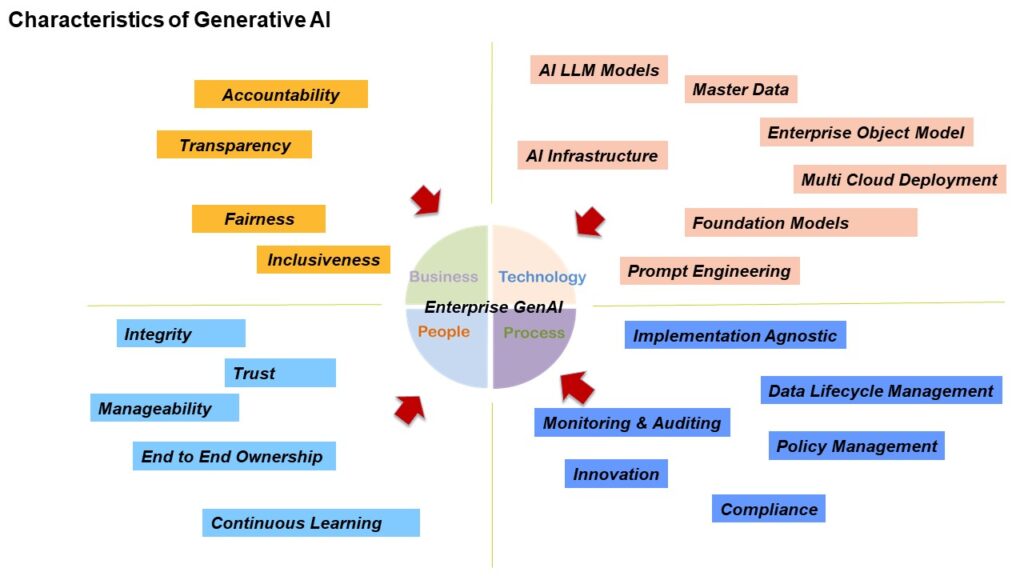
By Dr. Gopala Krishna Behara
Today, every IT vendor is hammering the drum for Generative AI. The same is true with recent seminars and conferences on IT technology. The speakers always mention Generative AI.
In software development, a smaller, quicker turnaround time is usually better. Enterprises are adopting next generation technologies like AI/ML, big data, IoT, blockchain, Cloud, API to revolutionize their business capabilities and deliver value to business with greater speed.
Many enterprises are trying to be part of the rat race and under peer pressure to implement GenAI without thinking about business needs. Sometimes, Generative AI (GenAI) is used for situations that can be solved by simple “If-then-else” statements. For every business problem, the enterprise leadership team is trying to force fit GenAI solution without verifying whether the solution can be fulfilled based on existing data platform, using existing technologies and tools, Cloud-based solution and number of software solutions available across enterprise.
Many CXO’s see the IT budget as an area of overspending and are continuously looking for ways to reduce costs and effort. Driving business outcomes with Generative AI requires strategy and collaboration from enterprise teams. Clearly establish a business case that addresses “Why Generative AI”, “What Enterprise Objectives” it tries to achieve. Identify the business use cases that are relevant to Generative AI and how verify the implementation of these relevant use cases by the competitor enterprises.
The following strategy level questions help to understand about the enterprise readiness for the Generative AI adoption.
- Is there a CXO mandate for Generative AI
- How does the Generative AI help in enhancing existing processes and enterprise strategy
- Is there an internal business case built? If so, at what level
- Is existing MLOps-tech stack and platform licenses fuel Generative AI, or are third-party services required
- Does the workforce possess the skills to use Generative AI, and what are the implications for talent acquisition and upskilling
- What risks emerge when deploying Generative AI and how do these risks impact Generative AI value
In summary, there exist numerous articles and blogs on Generative AI best practices, designing good services, and a robust supporting backbone. The following section of the paper summarizes when to adopt Generative AI and when not to use Generative AI.
Characteristics of Generative AI
Generative AI is a set of models that describe what we want, visualizing and generating content to match prompts. Generative AI accelerates ideation, brings vision to life and frees up to spend more time on being creative. It creates a wide variety of data such as images, videos, audio, text and 3D models. Typically uses large language models, example: ChatGPT, OpenAI.
The below diagram depicts the major characteristics of Generative AI which are classified as,
- Business
- Technology
- Process
- People

Figure 1: Characteristics of Generative AI
Business
- Accountability: Create an oversight so that humans can be accountable and in contact. Assess the impact of the system on people and enterprises
- Transparency: Design AI systems for decision making. AI systems are designed to inform people that they are interacting with an AI system
- Fairness: AI systems are designed to provide a similar quality of service for identified demographic groups
- Inclusiveness: AI systems are designed to be inclusive in accordance with enterprise accessibility standards
Technology
- AI LLM Models: Generative AI platform support an integrated full life cycle algorithm development experience
- Foundation Models: These are deep learning models. They are trained on huge quantities of unstructured and unlabeled data to perform specific tasks. It acts like a platform for other models. To process large amounts of unstructured text the foundation models leverage Large Language Models (LLMs)
- Master Data: Integrate data from numerous systems into a unified federated data. Data must be current and real-time
- Prompt Engineering: It is a process of designing, refining, and optimizing input prompts to guide a generative AI model toward producing desired outputs
- AI Infrastructure: It consists of storage and compute. It handles vast volumes of data needed for generative AI applications
- Multi Cloud Deployment: It supports multi-cloud operation
Process
- Implementation Agnostic: Implementation supports multiple development platforms and AI/ML tools and technologies
- Data Life Cycle Management: The data sources provide the insight required to solve business problems. The data sources are structured, semi-structured, and unstructured. AI based solutions support processing of all types of data from a variety of sources
- Policy Management: It ensures appropriate access to enterprise data assets. It covers, Role-based access control and content-based policies to secure enterprise data asset
- Compliance: It needs to address the alignment with enterprise risk management and ensuring compliance with regulations and assessment frameworks. AI Risk management should audit the AI Tools usage and effective usage of AI Models across enterprise.
- Innovation: New versions of AI/ML solutions can be deployed more rapidly, making it easier to experiment and innovate. Create AI/ML Roadmap
- Monitoring and Auditing: Analyze and optimize the portfolio of business strategies, enterprise Al structures, business processes / tasks and activities, information flows, applications, and technology infrastructure
People
- Integrity: Generative AI systems interact with entire enterprise providing integrity from the foundation level
- Trust: Build AI Open Systems, sharing source code, training data, and other relevant information. It protects the personal information and system integration
- End-to-End Ownership: Governance, ethics, integrity, and security need to be built in from inception
- Continuous Learning: Empower the individuals. Establish the process of continuous human learning and improved decision making
When to do Generative AI
Generative AI is used to automate tasks that require human involvement. It can be used to analyze large data sets to identify the patterns and generate insights into customer preferences and behavior to help businesses better.
Generative AI use cases are endless, and they are evolving continuously. Businesses across industry are experimenting with different ways to incorporate Generative AI. Also, there is a high demand for increased efficiency and improved decision-making capabilities across industries. Generative AI applications improve experiences, reduce costs, and increase revenues for enterprises.
The following are the Key Capabilities which drive the enterprise to use Generative AI as their solution.
- Text Management: Generative AI can complete a given text in a coherent manner. It can translate text from one language to another. It can summarize text into a shorter and concise form. It can generate text that mimics human writing.
- Contextual Understanding: Generative AI has a strong ability to understand the context.
- Natural Language Processing: It can perform various NLP tasks. Understand and process human language, allowing users to ask questions in a conversational manner.
- Question Answering: Generative AI can answer questions based on the knowledge base.
- Personalization: Generative AI can be fine-tuned for specific use cases.
- Multi-Language Support: Generative AI can perform NLP tasks in multiple languages.
- Advanced Semantic Search: Enables semantic search through Large Volumes of structured and unstructured data, including databases, documents etc. Also, supports auto data indexing using Custom AI/ML based data processing for efficient embedding.
- Content Moderation: Smart content filtering and moderation engine for Query & Response training on Enterprise specific data.
- Integration: Can be integrated with various applications/data sources within an organization, including CRM, ERP, and other proprietary systems, to access and analyze data via API.
- Role-based access control: The system can be set up with role-based access control, ensuring that users can only access and query data that they are authorized to view.
- Software coding: Code generation, translation, explanation, and verification.
When Not to Do Generative AI
The following are the factors, which negates the usage of Generative AI,
- Creativity: It cannot create, conceptualize, or plan strategically. That means, it cannot draw conclusions or make decisions based on complex situations
- New Ideas: It can only produce results that are like what has been done before. It cannot generate new ideas or solutions
- Empathy: It cannot feel or interact with feelings like empathy and compassion. AI cannot make another person feel understood and cared for
- Multitasking: Most AI systems are highly trained to solve specific problems in a sequential manner. It cannot perform different types of tasks at once
- Decision Making: It can make decisions based on data, but it cannot make ethical or moral decisions
- Explainability: It provides answers and predictions based on the algorithms and data models that it uses to learn. but consumers of AI-powered products aren’t likely to know exactly what information the AI uses for decision-making
The main challenges faced by the enterprises today in implementing Generative AI solutions are,
- Data Preparation: Identification of data sources for AI, labeling of data for algorithms, data management, data governance, data policies, data security, and data store are the challenges for the enterprises.
- Reliability: Trained models are black boxes and has no clue to end user. This may lead to false, harmful, and unsafe results.
- Security Risks: Cloud models may leak proprietary data, IP, PII, and model interaction history.
- Technology complexity: Data preparation for LLMs, algorithm design, building of models, training the models is a complex task. Compute identification for training, cloud identification and deployment are complex tasks.
- Huge Customization: Enterprise business needs require extensive Fine tuning of base foundation models and prompt engineering.
- Skill Gap: Generative AI initiatives require Machine Learning/Deep Learning/Prompt Engineering/Large Language Model expertise to build and train Foundation Models. Many enterprises lack these skilled resources and are not available in-house. Enterprises building algorithms and models to meet the business requirement will be a challenge.
Other challenges of Generative AI models are,
- Uncontrolled output
- Unpredictable output
- Generate output that may be false or illegal
- Copy right and legal challenges
Conclusion
There is a big gap in understanding what Generative AI can do and what enterprises would like it to do. From assessing business needs to building Generative AI solution it is necessary to make the right choice for enterprise business use case.
Generative AI Technology is changing the way the business runs. Generative AI helps in faster product development, enhanced customer experience and improved employee productivity. Generative AI implementation includes definition of AI strategy, identifying opportunities, gathering data, organizing data engineering, architect, proof testing of AI initiative, learnings, and enterprise-wide implementation.
In summary, Generative AI is going to stay and will only get better with future versions. Unlike previous technologies, Generative AI can make increasingly complex decisions enabling new business opportunities. The use of Generative AI across enterprises is becoming more and more widespread, possibly even trending toward industrialization.
Acknowledgements
The author would like to thank Santosh Shinde of BTIS, Enterprise Architecture division of HCL Technologies Ltd for giving the required time and support in many ways in bringing this article as part of Architecture Practice efforts.
About Author
Dr. Gopala Krishna Behara is an Enterprise Architect in BTIS Enterprise Architecture division of HCL Technologies Ltd, India. He has a total of 28 years of IT experience. Reached at gopalakrishna.behara@hcl.com.
Disclaimer
The views expressed in this article/presentation are that of authors and HCL does not subscribe to the substance, veracity or truthfulness of the said opinion.
